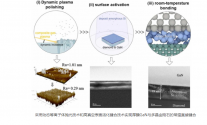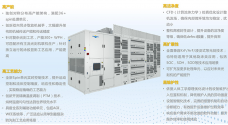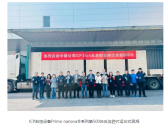Recently, the team of researcher Liu Xinyu from the High Frequency and High Voltage Center of the Institute of Microelectronics, in cooperation with Tianjin Zhongke Jinghe Company and other units, has made new progress in the field of direct bonding technology between thick film gallium nitride (GaN) and polycrystalline diamond. This study uses dynamic plasma polishing (DPP) technology to reduce the convex peak height on the polycrystalline diamond surface from 15nm to 1.2nm, obtaining a smooth surface with a surface roughness of 0.29nm, and combines it with the surface activation bonding method at room temperature. Achieved direct bonding of ~370μm GaN and ~660μm polycrystalline diamond substrate, with a bonding rate of ~92.4% and can withstand ambient temperatures of -55℃~250℃, providing an effective solution for wafer-level polycrystalline diamond bonding technical approach.
In recent years, the GaN/diamond heterogeneous integration method has become one of the effective ways to achieve high reliability and high power density GaN-based high electron mobility transistors (HEMTs). Direct wafer bonding technology has the advantages of high interface thermal conductivity and low thermal stress, and is promising in the integration of materials and devices, but it has high quality requirements such as material surface profile and roughness. At present, single crystal diamond can barely obtain the low surface roughness and high flatness required for direct bonding through chemical mechanical polishing technology (CMP), and small-size direct bonding can be achieved in the early stage. However, the large-size growth problem of single crystal diamond greatly limits its application, and the cost remains high. Polycrystalline diamond has the advantages of low cost and large size, but it has many problems such as many grain boundaries, uneven stress, irregular pits and ridges, etc., making it difficult for CMP technology to meet the requirements of surface roughness and surface flatness at the same time. and other requirements, it is difficult to achieve direct bonding. On the other hand, thick-film GaN can be combined with technologies such as Smart-Cut® to achieve compound semiconductor manufacturing and heterostructure construction, but thick-film GaN bonds also face greater stress issues. Currently, there are very few studies on the direct bonding of thick-film GaN and polycrystalline diamond.

This study uses plasma polishing technology with dynamic incident angles to solve surface morphology problems such as polycrystalline diamond flatness and roughness in a pressure-free state, combined with an ion beam surface activation bonding method assisted by in-situ silicon nanolayer deposition. The heterogeneous integration of thick film GaN and polycrystalline diamond was achieved, with a bonding rate of ~92.4%. The team used variable temperature confocal Raman spectroscopy technology to study the residual stress of the GaN/diamond bonding interface in the temperature range of -55°C to 250°C and its changes with temperature. They found that the GaN/diamond bonding interface at room temperature has ~200 MPa residual stress, and the interface stress increases asymmetrically when the temperature increases, that is, the stress on the diamond side increases significantly, while the stress on the GaN side does not change much. This is attributed to the fact that GaN and silicon nanobonding auxiliary layers have similar coefficients of thermal expansion (CTE), while the CTEs of diamond and silicon nanobonding auxiliary layers are quite different. This asymmetric interfacial stress demonstrates the effectiveness of the amorphous silicon nanolayer as a buffer layer to relieve stress.





